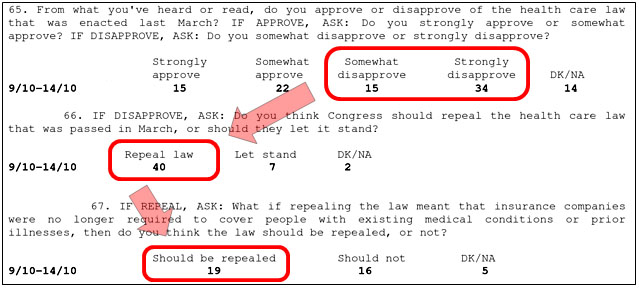I won’t pretend that I really know what this means, but here are the results from yesterday’s New York Times poll related to healthcare reform. Follow the bouncing arrow:

So: 49% of Americans disapprove of healthcare reform. That’s not good. But wait! Only 40% actually want it repealed. The rest figure it should be given a chance even if they don’t like it much. That’s better. And if you tell them that repeal would also mean repealing the preexisting condition provision, only 19% want it repealed. That’s better still.
Now, none of this changes the broad political fact that “healthcare reform” as a standalone campaign pitch seems to be a loser. That’s not what I expected this far after the bill was signed, but other polls confirm it. However, it’s also the case that what the bill actually does seems to remain pretty popular. This poll only asks about one particular provision, but previous polls have gotten similar results for most (though not all) of the bill’s other provisions.
Now there are two ways you can work with this result. The first is the complicated way: you explain that the bill bans companies from dropping customers with preexisting conditions (hooray!), but if you do that then you also have to insist that healthy people all get insurance too. Otherwise insurance companies will go out of business due to cherry picking. And if you do that, then you have to subsidize working class families that can’t afford insurance and expand Medicaid for poor families who can’t even afford subsidized private care. And once you’ve done that, that’s 90% of healthcare reform right there.
This is all true, but your audience’s eyes will glaze over about five seconds after the word “preexisting.” Still, there’s also an easy way to do this: just stop. Don’t explain the whole bill, just campaign on the preexisting condition clause. And also the tax credits, the end of the doughnut hole, the end of copayments for preventive care, the end of lifetime limits, the subsidies, and the Medicaid expansion. Oddly, though, that seems to be harder than it appears. Tim Kaine tried this tack on Jon Stewart the other night, and Stewart practically sneered him off the stage for it. It’s true that Kaine didn’t do a very good job, but still. Stewart is a pretty sympathetic audience.
So….it’s a mystery. People generally like the provisions of the law, but they yawn (or worse) when you tell them about all those provisions. I’m not sure what to make of this aside from concluding that people are just in a bad mood and it doesn’t matter what you say to them.

















